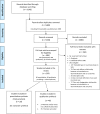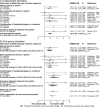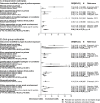Associations between sex work laws and sex workers' health: A systematic review and meta-analysis of quantitative and qualitative studies
- PMID: 30532209
- PMCID: PMC6289426
- DOI: 10.1371/journal.pmed.1002680
Associations between sex work laws and sex workers' health: A systematic review and meta-analysis of quantitative and qualitative studies
Abstract
Background: Sex workers are at disproportionate risk of violence and sexual and emotional ill health, harms that have been linked to the criminalisation of sex work. We synthesised evidence on the extent to which sex work laws and policing practices affect sex workers' safety, health, and access to services, and the pathways through which these effects occur.
Methods and findings: We searched bibliographic databases between 1 January 1990 and 9 May 2018 for qualitative and quantitative research involving sex workers of all genders and terms relating to legislation, police, and health. We operationalised categories of lawful and unlawful police repression of sex workers or their clients, including criminal and administrative penalties. We included quantitative studies that measured associations between policing and outcomes of violence, health, and access to services, and qualitative studies that explored related pathways. We conducted a meta-analysis to estimate the average effect of experiencing sexual/physical violence, HIV or sexually transmitted infections (STIs), and condomless sex, among individuals exposed to repressive policing compared to those unexposed. Qualitative studies were synthesised iteratively, inductively, and thematically. We reviewed 40 quantitative and 94 qualitative studies. Repressive policing of sex workers was associated with increased risk of sexual/physical violence from clients or other parties (odds ratio [OR] 2.99, 95% CI 1.96-4.57), HIV/STI (OR 1.87, 95% CI 1.60-2.19), and condomless sex (OR 1.42, 95% CI 1.03-1.94). The qualitative synthesis identified diverse forms of police violence and abuses of power, including arbitrary arrest, bribery and extortion, physical and sexual violence, failure to provide access to justice, and forced HIV testing. It showed that in contexts of criminalisation, the threat and enactment of police harassment and arrest of sex workers or their clients displaced sex workers into isolated work locations, disrupting peer support networks and service access, and limiting risk reduction opportunities. It discouraged sex workers from carrying condoms and exacerbated existing inequalities experienced by transgender, migrant, and drug-using sex workers. Evidence from decriminalised settings suggests that sex workers in these settings have greater negotiating power with clients and better access to justice. Quantitative findings were limited by high heterogeneity in the meta-analysis for some outcomes and insufficient data to conduct meta-analyses for others, as well as variable sample size and study quality. Few studies reported whether arrest was related to sex work or another offence, limiting our ability to assess the associations between sex work criminalisation and outcomes relative to other penalties or abuses of police power, and all studies were observational, prohibiting any causal inference. Few studies included trans- and cisgender male sex workers, and little evidence related to emotional health and access to healthcare beyond HIV/STI testing.
Conclusions: Together, the qualitative and quantitative evidence demonstrate the extensive harms associated with criminalisation of sex work, including laws and enforcement targeting the sale and purchase of sex, and activities relating to sex work organisation. There is an urgent need to reform sex-work-related laws and institutional practices so as to reduce harms and barriers to the realisation of health.
Conflict of interest statement
The authors have declared that no competing interests exists.
Figures




References
-
- Rekart ML. Sex-work harm reduction. Lancet. 2005;366:2123–34. 10.1016/S0140-6736(05)67732-X - DOI - PubMed
-
- Shannon K, Strathdee SA, Goldenberg SM, Duff P, Mwangi P, Rusakova M, et al. Global epidemiology of HIV among female sex workers: influence of structural determinants. Lancet. 2015;385(9962):55–71. 10.1016/S0140-6736(14)60931-4 - DOI - PMC - PubMed
-
- Deering KN, Amin A, Shoveller J, Nesbitt A, Garcia-Moreno C, Duff P, et al. A systematic review of the correlates of violence against sex workers. Am J Public Health. 2014;104(5):e42–54. 10.2105/AJPH.2014.301909 - DOI - PMC - PubMed
-
- Potterat JJ, Brewer DD, Muth SQ, Rothenberg RB, Woodhouse DE, Muth JB, et al. Mortality in a long-term open cohort of prostitute women. Am J Epidemiol. 2004;159(8):778–85. - PubMed
Publication types
MeSH terms
Grants and funding
LinkOut - more resources
Full Text Sources

